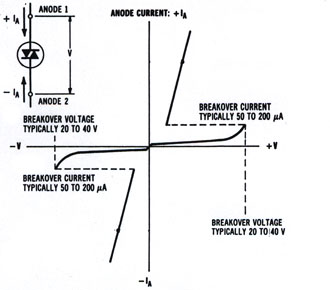The diac is a bidirectional trigger diode which is designed specifically to trigger a triac or SCR. Basically the diac does not conduct (except for a small leakage current) until the breakover voltage is reached. At that point the diac goes into avalanche conduction also at that point the device exhibits a negative resistance characteristic, and the voltage drop across the diac snaps back, typically about 5 volts, creating a breakover current sufficient to trigger a triac or SCR. A typical characteristic is shown below with its schematic symbol:

Although most diacs have symmetric switching voltages, asymmetric diacs are available. Typical diacs have a power dissipations ranging from 1/2 to 1 watt.
The main characteristics are:
(a) Breakover voltage
(b)Voltage symmetry
(c) Breakback voltage
(d) Breakover current
(d) Power dissipation
Typical diacs that are supplied by American Microsemiconductor
| ELECTRICAL CHARACTERISTICS (T=25oC) | |||||
| PART NUMBER |
Breakover Voltage V |
Breakover Voltage SymmetryV | Dynamic Breakback Voltage V |
Breakover Current 渙 |
Peak Pulse Current A |
| Min Typ Max | MAX | MIN | MAX | MAX | |
| D30 | 28 32 36 | 3 | 5 | 100 | 2.0 |
| D40 | 35 40 45 | 3 | 5 | 100 | 2.0 |
| ST2 | 28 32 36 | 3.8 | – | 200 | – |
| HT32 | 27 – 37 | 3 | 5 | 50 | 2.0 |
| DB3 | 28 32 36 | 3 | 5 | – | 1.0 |


Leave A Comment